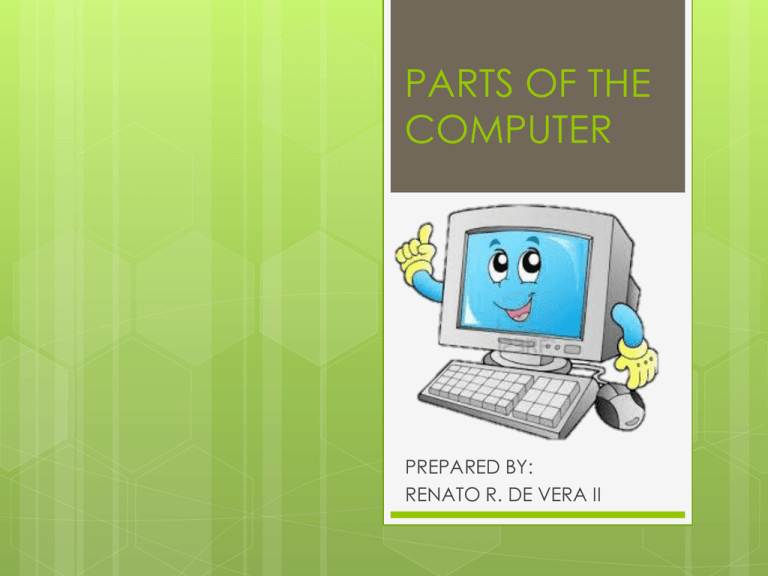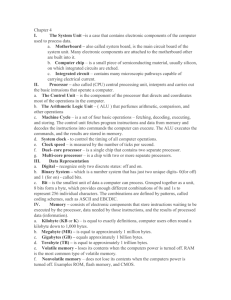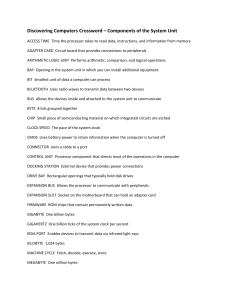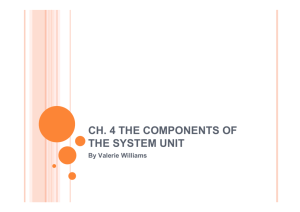parts of the computer
advertisement

PARTS OF THE COMPUTER PREPARED BY: RENATO R. DE VERA II COMPUTER PARTS SYSTEM UNIT MONITOR PRINTER SPEAKER KEYBOARD is MOUSE an electronic device that can store, process, and retrieve data. Monitor A monitor displays information in visual form, using text and graphics. The portion of the monitor that displays the information is called the screen. SYSTEM UNIT a rectangular box placed on or underneath your desk. PARTS Power Outlet PS/2 Mouse Port PS/2 Keyboard Port Serial Parallel Video Port IEEE 1394a Port USB 2.0 Ports RJ45 LAN1 Port Audio I/O Ports Coaxial S/PDIF Out Port Add-on video adapter MOUSE PARTS RIGHT OR ALT MOUSE BUTTON SCROLL WHEEL LEFT MOUSE BUTTON A mouse is a small device used to point to and select items on your computer screen. KEYBOARD A keyboard is used mainly for typing text into your computer. Like the keyboard on a typewriter, it has keys for letters and numbers, but it also has special keys PARTS Screen Controls Function Keys Escape Key Alpha Numeric Keys Numeric Keypad Arrow Key/ Navigation Key KEYBOARD The function keys, found on the top row, perform different functions depending on where they are used. The numeric keypad, located on the right side of most keyboards, allows you to enter numbers quickly. The navigation keys, such as the arrow keys, allow you to move your position within a document or webpage. SPEAKER Speakers are used to play sound. They may be built into the system unit or connected with cables. Speakers allow you to listen to music and hear sound effects from your computer. PRINTER A printer transfers data from a computer onto paper. You don't need a printer to use your computer, but having one allows you to print e-mail, cards, invitations, announcements, and other materials. THE COMPONENTS OF THE SYSTEM UNIT THE SYSTEM UNIT System unit is case that has electronic components of the computer used to process data. A motherboard or also know as system board, is the main circuit board of the system. A chip is a small piece of semi-conducting material, usually silicon, on which integrated circuits are etched. Integrated circuit contains many microscopic pathways capable of carrying electrical current. Most chips are not much bigger than one half inch square. PROCESSOR The central processing unit (CPU) interprets and carries out basic commands that run a computer. Multi-core processor is one chip with two or more separate processor cores. Dual core processor is a chip that has two separate processor cores. PROCESSOR cont… Quad core possessor is a chip with four separate processor cores. A control unit is the component of the processor that helps to direct and coordinate most of the functions in the computer. Arithmetic logic unit (ALU) is also a component of the processor, it performs arithmetic, comparison, and other operations. PROCESSOR cont… PROCESSOR cont… A processor contains small, high speed storage locations, called registers that temporarily hold instructions and data. The processor relies on a system clock that controls the timing of all the computer operations. The clock speed is measured by the number of ticks per second. DATA REPRESENTATION The binary system is a number system that has just two unique digits, 0 and 1. A bit also know as binary digit, is the smallest unit of data the computer can process. A byte is when eight bits are grouped together as a unit. PROCESSOR One gigahertz (GHz) = one billion ticks of the system clock per second. Computers today might use a high speed processor, in the Intel Core family. MEMORY Memory consists of electronic components that store instructions waiting to be executed by the processor, data needed by those instructions, and the results of processing the information. There are 2 types of memory, Volatile is temporary and nonvolatile is permanent memory. MEMORY SIZES Kilobyte (KB OR K) is equal to exactly 1,024 bytes. Megabyte (MB) is equal to about one million bytes. Gigabyte (GB) is equal to about one million bytes. Terabyte (TB) is equal to approximately one trillion bytes. MEMORY TERMINOLOGY Read Flash only memory (ROM) Memory Complementary (CMOS) Access time Nanosecond metal-oxide semiconductor EXPANSION SLOTS AND ADAPTER CARDS Expansion Adapter slots card Sound card Video card Plug and Play PORTS AND CONNECTORS A port is the point at which a peripheral attaches/communicates with a system unit so that the peripheral can send data to the computer. A jack is used to identify audio and video ports. A connector joints a cable to a port. Universal serial bus port (USB) PORTS AND CONNECTORS cont… FireWire port can connect multiple types of devices that require faster data speeds. FireWire hub plugs in a FireWire port on the system unit and contains multiple FireWire ports in which you plug cables form the FireWire devices. (Small Computer System Interface) SCSI port PORTS AND CONNECTORS cont… eSATA Bluetooth IrDA Serial MIDI PORT TYPES BUSES Buses are used to transfer bits from input devices to memory, from memory to the processor, from the processor to memory, and from memory to output/storage devices. Word size is the number of bits the processor can interpret and execute at a given time. END



